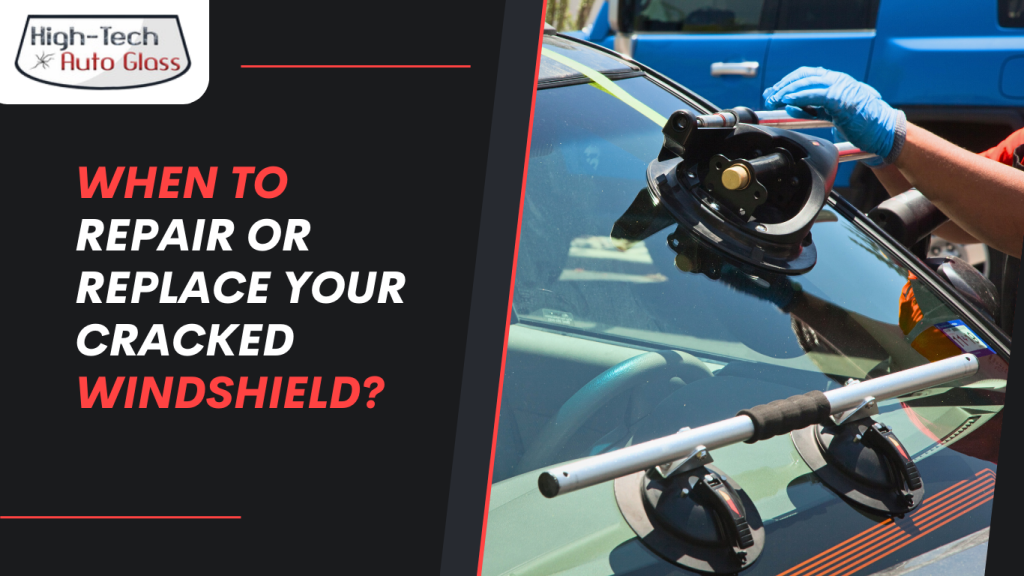When to Repair or Replace Your Cracked Windshield?

A windshield is not just a piece of glass; it’s an important component of your vehicle’s safety system. It provides structural strength to your car’s cabin and supports the performance and functionality of airbags during accidents. Ensuring that the windshield remains intact and damage-free is vital for maintaining clear visibility and protecting passengers from external elements and in case of collisions. Whether it’s a small crack or major damage, the decision between repairing your windshield or replacing it depends on the severity of the damage, as the safety of your windshield depends on addressing issues promptly.
When it comes to addressing a cracked windshield, understanding whether to opt for a windshield repair or replacement is essential. The decision largely depends on the type, size, and location of the damage in the car windshield, such as a crack or chip. While a crack may not seem like a major issue at first, it can quickly worsen if left unattended. To understand how to prevent it from getting worse, refer to our guide on how to stop windshield crack from spreading. In some cases, repairing a badly damaged windshield instead of replacing it may compromise safety, making it important to assess the severity of the damage carefully. Smaller cracks and chips in the damaged windshield may often need to be repaired, preserving the original seal around the glass. In cases where a replacement might not be ideal, you may explore options to repair the cracked windshield without replacing.
However, larger or more strategically problematic damage may necessitate replacing the entire broken windshield with a new one to ensure safety and durability. Both processes – repairing a cracked windshield and replacement – are important for restoring the integrity and functionality of your windshield, preventing it from further shattering or compromising the vehicle’s safety.
What Causes Windshield Damage?
Windshield damage can occur from multiple sources. For instance, if a rock hit my windshield, it could cause a small chip or crack that penetrates the glass, which may expand over time. Road debris like stones often impacts the glass when driving, especially on busy roads or near construction sites, leading to various types of glass damage such as chips or cracks. If you’re facing chipped glass, learn more about how to fix a chipped windshield. Accidents can cause extensive damage, often requiring a full windshield replacement. Temperature fluctuations can make the glass expand and contract, resulting in stress cracks. Curious if such cracks can occur on their own? Find out whether windshields can crack on their own.
Additionally, poor installation might not secure the windshield properly, making it vulnerable to damage from regular driving stress. Furthermore, using low-quality glass for replacements can increase susceptibility to damage, leading to a more severe crack in your windshield, as these may not comply with OEM standards. If the crack grows beyond the length of a dollar bill, it becomes even more critical to address the issue immediately to avoid further compromising the structural integrity of the windshield.
For more detailed insights, explore our related topic: Can Windshields Crack on Their Own?.
Addressing the Damage
When to Repair
The decision to repair a windshield often hinges on two serious factors: the size and location of the damage.
- Size: Generally, chips smaller than a quarter and cracks that are less than three inches long can be effectively repaired. Repairing these smaller damages can restore the structural integrity of the windshield and prevent further spreading.
- Location: If the damage is located outside of the driver’s direct line of sight, repair is more feasible. Damage within the driver’s primary viewing area often requires replacement due to the difficulty of making a repair that does not impair visibility.
Repairing minor windshield glass damage is not only cost-effective but also keeps the original glass in place, which is beneficial for maintaining factory seals and avoiding potential leaks or defects associated with replacement. A quality windshield repair ensures that the damage is repaired properly, preserving the integrity of the windshield and preventing further complications down the road.
When Replacement is Necessary
The depth of a crack or chip can also determine the necessity for replacement. If the damage penetrates more than halfway through the windshield, it compromises the structural integrity, making the need for a full windshield replacement necessary. When assessing the damage, you may wonder, can it be repaired or do I need a full replacement? This depends largely on how deep and extensive the damage is.
Different types of damage can also dictate the need for a windshield replacement:
- Penetrating Damage: Damage that goes through the windshield, affecting both the outer and inner layer of glass.
- Pervasive Cracking: Multiple cracks that spread from a central point, or long cracks that extend across the windshield, cannot typically be repaired and require replacement.
- Large Cracks or Chips: When a crack or chip is large, especially if it’s bigger than a quarter for chips or longer than three inches for cracks, need a windshield replacement is often necessary to ensure safety and restore structural integrity.
- Damage in serious Areas: If the damage is located in serious areas of the windshield, such as the driver’s line of sight, it can distort the view and affect driver safety. In such cases, replacement is recommended to maintain clear visibility and adhere to safety standards.
- Edge-to-Edge Cracks: Cracks that span from one edge of the windshield to another often indicate severe structural compromise. Such damage typically requires a full windshield replacement to restore the vehicle’s structural strength and ensure safety.
In cases where the type or depth of damage poses a risk to vehicle safety or the effectiveness of airbags during a collision, replacing the windshield becomes essential. If you’re unsure about the best course of action, you might want to explore whether you can drive with a cracked windshield until you arrange for a repair or replacement. Ensuring the windshield is in excellent condition is important for maintaining visibility and safety while driving.
Once it’s determined that a new windshield is needed, the next step is to carefully remove the old one. This process can be particularly challenging if you are dealing with rear windshields, and you can follow our step-by-step guide on how to replace a rear windshield to understand better.
Conclusion
In the comprehensive guide provided, we explored various aspects of windshield damage, addressing when it’s appropriate to repair or replace your windshield. Understanding the different types of windshield cracks – such as chips, star breaks, and edge cracks, along with what causes these damages, like road debris, accidents, and temperature changes, is important for any vehicle owner. Whether it’s minor damage or severe enough to warrant replacing your windshield with a new windshield, knowing the right steps to take is crucial for maintaining your vehicle’s safety.
We investigate specifics like the size, location, and depth of damage to determine whether it’s possible to repair or if the windshield has to be replaced. Minor damages often qualify for repair, but when the damage is extensive, deep, or seriously located, you may need to replace the whole windshield to ensure safety and maintain the integrity of the vehicle. This guide covers both repair and replacement options to help you make an informed decision.
High Tech Auto Glass stands out as a leading provider of Windshield Replacement Phoenix. With their expertise, High Tech Auto Glass not only helps in making informed decisions about whether to repair or need to replace a windshield but also ensures that each service is executed with the highest standards of quality and safety. Choosing High Tech Auto Glass means opting for reliability and excellence, ensuring that your vehicle remains safe and visually clear, enhancing your driving experience.
Whether your windshield is made from laminated glass or another material, choosing High Tech Auto Glass means you can trust that any damage is repaired properly. Opting for High Tech Auto Glass means choosing reliability and excellence, ensuring that your vehicle remains safe and visually clear, enhancing your driving experience.
Frequently Asked Questions
What should I do if my windshield gets cracked while driving?
If a crack appears while you’re on the road, try to avoid potholes and rough surfaces, which can make the crack spread. Drive at a moderate speed and avoid slamming doors until you can get it repaired.
Can temperature changes make windshield cracks worse?
Yes, extreme hot or cold temperatures can cause a crack to expand. Avoid blasting the heater or air conditioner directly onto the windshield and park in shaded or covered areas when possible.
Is there a way to prevent small chips from turning into big cracks?
Yes, getting small chips repaired quickly can prevent them from expanding into larger cracks. Also, avoid driving on rough terrain, and try to keep a steady speed to minimize windshield stress.
Can I wash my car immediately after a windshield replacement?
It’s best to wait at least 24 hours before washing your car after a windshield replacement. High-pressure water or brushes can affect the adhesive seal while it’s curing.
Can I drive my car immediately after a windshield replacement?
Most experts recommend waiting at least one hour before driving your car after a windshield replacement to allow the adhesive to set properly.
Can a windshield with multiple chips or cracks be repaired?
It depends on the number, size, and location of the chips or cracks. Generally, if there are multiple damages, especially near the edges, a replacement may be necessary for safety reasons.
Are there any DIY Kit solutions for small windshield chips?
There are DIY repair kits available for minor chips, but they require careful application. For best results, consider consulting a professional to ensure the repair is done correctly and safely.
